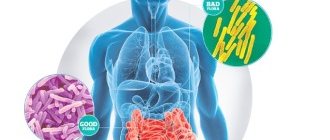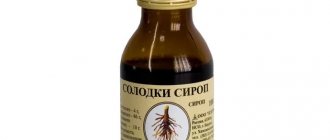The human intestine contains a great variety of different bacteria and microorganisms, both beneficial and pathogenic. The largest number are lactobacilli and bifidobacteria. There is a kind of balance in the numerical ratio of all intestinal bacteria, this is called microflora. When this balance is disturbed, dysbiosis occurs. Positive microorganisms simply cannot cope with their work and do not have time to produce a sufficient amount of useful substances. What drugs exist to restore intestinal microflora?
Types of drugs that restore intestinal microflora
To restore the disturbed balance, there are a large number of drugs for intestinal microflora, which can be divided into three groups:
- Probiotics containing live cultures of microorganisms (Linex, Bifidumbacterin, Acepol, etc.)
- Prebiotics are drugs that enhance the growth and reproduction of beneficial bacteria. These include Duphalac, Lactusan and Normaze, which contain lactulose.
- Synbiotics are a complex of living bacteria and substances that enhance their growth. Among the most famous Biovestin are Lacto, Bifido-bak, Maltidophilus.
Probiotics, in turn, can also be divided into several subtypes. Preparations containing only one strain of bacteria include Lactobacterin, Bifidumbacterin and others. If a drug contains several strains of bacteria, it is called multicomponent. The most famous among multicomponent drugs is Linex. Probiotics containing live bacteria are Probifor, Bifidumbacterin forte.
Probiotics are generally safe and do not cause any side effects. They cannot always be replaced with folk remedies; it is better to take them together or use traditional medicine to consolidate the results. However, it is important to remember that not all advertising is true; before purchasing any drug for dysbiosis, you must consult a doctor, and also choose medications only from well-known manufacturers and in trusted pharmacies.
If the intestinal microflora needs help
Often the gastrointestinal tract works overtime. Especially on holidays and during vacations. Overeating, lack of diet and, for those who are especially lucky, intestinal infections are all the other side of the excesses that we allow ourselves at the table.
Winter and the intestines: what is the connection?
It is important to arrange rehabilitation of your gastrointestinal tract after gastronomic exploits. After all, we need his strength so much now. The cold season is a period during which all the body’s immune forces are activated, and the intestines are one of the most important immune organs.
The totality of intestinal microorganisms (microbiota) is directly involved in the activation of the body's immune systems. The intestinal microflora for the most part consists of bifidobacteria and lactobacilli, which perform functions that are very important for our immunity:
- prevent the emergence of pathogenic microflora;
- produce enzymes to digest food;
- participate in the synthesis and absorption of vitamins and many other important elements;
- are responsible for the production of lymphoid cells, which subsequently perform their defensive function in other organs;
- participate in the formation of the immune response to foreign bacteria and microorganisms;
- support the intestinal immune system, which produces IgA immunoglobulins.
That is why, only if the microflora is normal, the intestines are able to perform their protective functions and it is easier for the body to resist viral diseases.
Do I have problems with microflora?
Signs of dysbiosis are difficult to miss. Everyone has encountered these symptoms at least once in their life:
- dyspepsia (nausea, flatulence, heartburn, heaviness in the stomach);
- stool disorders (diarrhea, constipation);
- the occurrence of food allergies;
- increased fatigue, decreased mood, signs of depression, lethargy;
- deterioration of skin and hair condition;
- rapid weight gain or loss.
If you find yourself with the listed symptoms, then you should think about how to support your body during the difficult autumn-winter period.
To begin with, it is worth noting that in order to normalize the functioning of the intestines, it is necessary first of all to eliminate factors that negatively affect its functioning: stress, poor diet, alcohol, smoking. As soon as you return to a healthy lifestyle, the body will begin to restore the normal functionality of the intestinal tract. Also, some medications have a destructive effect on the state of microflora: antibiotics, antidepressants, hormonal and others.
Of course, for most of us it is quite difficult to suddenly give up bad habits and start eating only healthy foods. Yes, and stopping taking a drug prescribed by a doctor is also a bad idea. For such cases, there are drugs that normalize the intestinal microflora, namely, probiotics and prebiotics.
Pro- or pre-: what's the difference?
Probiotics are live microorganisms that are normally present in the intestines of every healthy person and, when administered in adequate quantities, provide benefits. These include:
- lactobacilli (L. casei, L. acidophilus, etc.);
- bifidobacteria (B. bifidum, B. infantis, B. longum, etc.);
- lactic acid streptococcus;
- non-pathogenic varieties of enterococcus;
- non-pathogenic varieties of Escherichia coli.
Manufacturers produce a wide variety of dietary supplements and over-the-counter medications containing one (single-component) or several (multicomponent) probiotics. The range of these drugs is presented in different forms of release: powders in sachet, capsules with lyophilisates of bacteria, liquid forms, tablets and others.
Unfortunately, there is no universal probiotic for all diseases, so the most effective drug will be one prescribed by a doctor depending on the causes of dysbiosis.
Prebiotics are substances that are not absorbed and partially or completely not digested by our body. Their consumption has a beneficial effect on the growth and reproduction of the intestinal’s own beneficial bacteria. That is, this is the food that probiotics need for normal functioning.
Based on their origin, they can be divided into substances:
- carbohydrate nature (monosaccharides, oligosaccharides, polysaccharides, sugar alcohols);
- protein nature (peptides);
- others (lactobionic acid, polyphenols).
The most commonly used prebiotics are lactulose, inulin, oligofructose and dietary fiber. All these substances are included in medications and dietary supplements, the mechanism of action of which is based on maintaining the balance and constancy of the intestinal microflora.
Without being digested in the previous sections of the gastrointestinal tract, they enter the large intestine in transit and there create comfortable conditions for the life of “native” microflora bacteria.
Together or apart?
Depending on the individual characteristics of the body, the causes, form and nature of dysbiosis, the prescribed dosage forms and rules for taking probiotics and prebiotics will differ. They can be used together, in turn, or in the form of synbiotics (preparations containing beneficial bacteria and a nutrient medium for them). Therefore, it is better to coordinate their choice with your doctor.
But there are general recommendations that are relevant for any drug regimen to normalize the microflora:
- Prepare the body with enterosorbent. This helps remove all toxins from the body before taking medications to normalize the microflora.
- Adjust your diet. Reduce your consumption of sugar and foods containing it, eat more complex carbohydrates, fiber and greens.
With the right preparation and regular use of probiotics and prebiotics, you will very soon feel light and energetic, and your intestines, in gratitude, will help your immune system resist all the adversities of the autumn-winter season.
Be healthy!
Sources:
- Kaibysheva, V. O. Probiotics from the position of evidence-based medicine / V. O. Kaibysheva, E. L. Nikonov // Evidence-based gastroenterology. - 2022. - 8 (3). — P. 45–54.
- Khramtsov, A. G. Prebiotics as functional food ingredients: terminology, criteria for selection and comparative evaluation, classification / A. G. Khramtsov, S. A. Ryabtseva, R. O. Budkevich [and others] // Nutrition Issues. - T. 87. - No. 1. - 2022. - P. 5–17.
- Bovbel, I. E. Modern ideas about the intestinal microbiota and the possibility of effective use of probiotics in the practice of a pediatrician / I. E. Bovbel // Medical news. — 2022. — No. 2. — P. 25–31.
- Microbiota / ed. E. L. Nikonova and E. L. Popova // Media Sphere. — 2022. — pp. 20–30.
Anna Gorobets, pharmacist, medical journalist
Photo depositphotos.com The author’s opinion may not coincide with the opinion of the editors
Anti-dysbacteriosis drugs for children
Dysbacteriosis in a child most often occurs when taking antibiotics that destroy the natural intestinal microflora. Often, after a course of antibiotics, mothers observe in their children poor appetite, diarrhea, constipation, vomiting, decreased immunity, as well as various allergic reactions due to increased intestinal permeability, and rash.
Infants can do without special medications. Recently, pediatricians have been inclined to believe that mother's breast milk is the best medicine. Therefore, mothers are advised to give up complementary feeding for a while and breastfeed only.
Let's take a closer look at what medications can be given to children and at what age:
- Linux. This is a biologically active food supplement, has a special dosage for children, and is available in the form of bagged powder. It is believed that this drug can be given from birth, observing a certain dosage. You can take it for up to a month, on the recommendation of your doctor.
- Primadophilus. This is a dietary supplement used for the intestines in both children and adults. For children, this supplement is available in powder form. It can be added to breast milk, formula, drinks, and taken with meals. It should only be stored in the refrigerator.
- Hilak forte. This drug is available in drops. It can be used from the first days of life. Infants are given from 15 to 30 drops at a time. However, it should not be given with milk or dairy products.
- Acipol is allowed to be taken by children from 3 months, 1 capsule 2-3 times a day. Of course, infants will not be able to swallow the capsule, so you need to carefully open it and pour the powder into the liquid.
- Normobakt. Available in powder form. Infants are given half a sachet per day, dividing the dose several times. Powder can be added to liquid, but not hot. The course of taking the drug is no more than 15 days.
- Bifidumbacterin. The drug in powder form is dissolved in a small amount of liquid and drunk without waiting for complete dissolution. For newborns, you can add it to milk or formula. It is advisable to take Bifidumbacterin with meals.
Dietary supplements: probiotics or prebiotics?
Our intestines are the largest organ of the immune system. The need for its coordinated and full-fledged work is difficult to overestimate. The main functions performed by various parts of the intestine are: digestion of food, absorption of micro and macroelements, nutrients. Also in the intestines live populations of microorganisms necessary to maintain biochemical, metabolic and immune balance. A healthy balance of all microorganisms is called normal flora, and those located precisely in the intestines are the microbiota of orgasm.
Microflora
The intestinal microflora consists of:
- The obligate part, which is the main microflora.
- Facultative, that is, additional, it includes opportunistic microorganisms (those that, if the balance is disrupted, can cause harm rather than benefit).
- The transient part is microorganisms that accidentally entered from the outside.
Let's dwell on the most important part, which includes bifidobacteria - they populate the intestines throughout its entire length, and are also present in the vaginal microflora. They took on a number of very important functions:
- The complex of interactions between bifidobacteria and the intestinal mucosa prevents toxins and pathogenic microorganisms from penetrating beyond the intestines into the body.
- Suppress the activity and growth of pathogenic microorganisms due to the production of organic fatty acids.
- They help to utilize leftover food and stimulate the process of parietal digestion.
- They synthesize a number of biologically active substances (amino acids, proteins, B vitamins including folic acid, nicotinic acid, pyridoxine).
- Enhances the absorption of calcium, iron and vitamin D.
Also, the obligate microflora includes lactobacilli, which play a very important protective role, and they protect the body from pathogens of acute intestinal infections entering the body. Without lactobacilli, a full balance with facultative microflora is impossible, since it inhibits the growth of a number of opportunistic bacteria. The protective function is carried out due to the production of lactic acid, hydrogen peroxide, lysozyme and other substances with antimicrobial activity during metabolism. Propionic bacteria also have this activity.
The next representative is E. coli, which helps digest lactose, synthesize vitamins: K, group B, and also produce antibiotic-like substances that prevent pathogenic bacteria from growing. A very important function is to stimulate the formation of antibodies.
Peptostreptococci are necessary to maintain a pH no higher than 5.5. The last but not least important representatives are enterococci, which are necessary for the fermentation of carbohydrates with the formation of lactic acid, and are in balance with E. coli.
Reasons for violations
This balance is quite easily destroyed by both external and internal factors.
In newborns this is:
- Vaginosis of the mother's vagina, mastitis.
- Late breastfeeding.
- Low Apgar score and resuscitation.
- A long stay within the walls of a hospital encourages the colonization of aggressive species of bacteria.
- Intestinal immaturity
- Purulent infections
- Lactose intolerance
- Immunodeficiency
- Malabsorption syndrome
Infancy and childhood:
- Early artificial feeding.
- Impaired intestinal motility.
- Frequent acute respiratory infections.
- Rickets, anemia.
- Mental development disorder.
- Atopic dermatitis
Preschool, adolescence:
- Closed groups.
- Allergy.
- Adverse habits (smoking, drug addiction, alcoholism).
- Frequent acute respiratory infections.
Middle age means occupational hazards, and in old age it means a change in the composition of the microflora. There are also objective factors independent of age:
- Frequent and severe stress.
- Gastrointestinal diseases.
- Taking certain hormonal medications.
- Undergoing radiation therapy or chemotherapy.
- Food poisoning.
- Malnutrition (dietary regime, composition and quality of food consumed).
- Failure of the immune system (immunodeficiency).
- Use of antibacterial therapy.
What you should pay close attention to and, if necessary, consult a doctor and understand that microbiota disturbances have arisen:
- belching
- rumbling in the stomach in the intestinal area
- Constantly feeling bloated
- abdominal pain, dull aching
- disturbance of stool consistency and regularity
- sour stool odor
- seizures, dry skin
- eating disorder (usually lack of appetite)
- the presence of an unpleasant taste in the mouth, as well as putrefactive or sour breath
- There is also nausea and vomiting
- due to asthenia and hypovitaminosis, fatigue and drowsiness
You should not try to diagnose yourself and self-medicate.
Nutrition
Prevention is a well-functioning balanced diet and the obligatory presence in it of products containing probiotic cultures (kefir, cottage cheese, sour cream, curdled milk, yogurt). The diet should also be rich in fiber. The use of probiotics and synbiotics in parallel with the use of antibacterial drugs.
Prevention is a well-functioning balanced diet
Drugs
It is worth considering in more detail what options currently exist for correcting the state of dysbiosis with the help of medications and dietary supplements. The following groups are distinguished:
Probiotics are directly bacteria and microorganisms. When taken, they act as a so-called “cover” for the intestinal microflora, creating favorable conditions for its growth and preventing opportunistic microorganisms from developing. For treatment they use: bifidobacteria, lactobacilli, E. coli, enterococci, streptococci, propionibacteria, fungi). Duration of treatment is at least 1 month.
In composition they are:
- Monocomponent, they contain only one type of microorganisms (Colibacterin, Bifidumbacterin, Lactobacterin, Probifor, Narine)
- Multicomponent ones contain several types (Acelact, Acipol, Linex, Bifiform, Normospectrum, Rioflora, Probifid, Bak-set)
- sorbed can also contain one or more types of bacteria that will be fixed on the sorbent
- combined, they additionally contain lysozyme or a nutrient medium (Bifidumbacterin Forte, Probifor, Ecoflor, Normobakt, Bion-3, Baktisuptil, Biosporin, Sporobacterin)
- metabolic
Prebiotics are nutrient substances for the intestinal microflora that are not absorbed: Inulin, Lactose, Lactulose. (Dufalak, Zakofalk, Liquid coal, Normasorb, Laktofiltrum).
Complex preparations in this group include all types of bacteriophages.
Synbiotics - a complex preparation containing probiotics and prebiotics (Maxilac, Laktobalans, Primadophilus)
Metabiotics - metabolites of intestinal microflora (Hilak forte, Baktistatin, Actoflor-S)
Literature:
Clinical protocol for the treatment of intestinal dysbiosis 2003
“Experimental and clinical gastroenterology” Article Intestinal dysbiosis: current state of the problem, comprehensive diagnosis and therapeutic diagnosis and treatment. 2015







